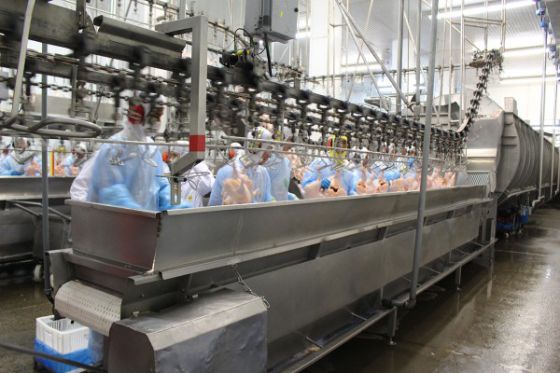JBS lidera registros de acidentes de trabalho em frigoríficos, segundo Ministério da Previdência Nos comerciais da Friboi na TV, o roteiro se repete. O ator Tony Ramos faz uma visita-surpresa à casa de um consumidor, para perguntar qual carne costuma comprar, e encontra um produto da marca na geladeira. “Carne confiável tem nome”, diz o artista. Quando fiscais aparecem repentinamente nas unidades da JBS, dona da Friboi, o resultado tende a ser previsível como a propaganda. Irregularidades e violações de direitos trabalhistas são tão frequentes que deixaram 7.822 funcionários da empresa doentes ou incapacitados para o trabalho nos últimos quatro anos. Isso equivale a cinco acidentes por dia durante todo o período. Dados inéditos obtidos pela Pública com o Ministério da Previdência Social, por meio da Lei de Acesso à Informação, mostram que a JBS foi a campeã em comunicados de acidentes de trabalho, de 2011 a 2014, somando-se os setores de abate de gado e de fabricação de produtos de carne. No setor de abate de aves – em que começou a se expandir nos últimos dois anos, com a compra da Seara e de outros frigoríficos –, a empresa já subiu para o segundo lugar em 2014 e ficou quase empatada com a BRF (antiga Brasil Foods). 
Linha de produção da unidade de Rolândia (PR), interditada após fiscalização. / MPT/PR Com lucro líquido de 2,04 bilhões de dólares em 2014, a JBS é hoje o maior grupo privado do país em faturamento e a maior processadora de carnes do mundo. No ano passado, as vendas somaram 120 bilhões de reais. Esse gigantismo foi conseguido com a ajuda de dinheiro público. O Banco Nacional de Desenvolvimento Econômico e Social (BNDES), por meio da BNDES Participações (BNDESPar), fez aportes de 8,1 bilhões de reais para favorecer aquisições, tornando-se seu maior sócio. A BNDESPar chegou a deter um terço do grupo. Em 2012, repassou uma cota equivalente a 10% de participação para a Caixa Econômica Federal e manteve-se com 24,5%. O grupo foi, também, o maior doador na campanha eleitoral do ano passado e destinou 366,8 milhões de reais a candidatos e partidos políticos. A maioria dos acidentes da JBS no país ocorreu no setor de abate de bovinos, uma área historicamente perigosa para os trabalhadores. Foram registrados 4.867 comunicados no total: 1.294 em 2011, 1.225 em 2012, 1.261 em 2013 e 1.087 em 2014. Nesse setor, a empresa foi responsável por um em cada quatro acidentes informados ao Instituto Nacional do Seguro Social (INSS) entre 2011 e 2013 – cerca de 25% ao ano. Houve redução de 14% nos comunicados da JBS de 2013 para 2014, mas a empresa ainda concentrou um em cada cinco acidentes reportados no último ano (21%) e ficou atrás apenas da Marfrig. Na área de fabricação de produtos de carne, foram 506 acidentes reportados em 2011, 262 em 2012, 327 em 2013 e 369 em 2014 (incluindo a Seara, comprada em 2013). Nos quatro anos, a JBS foi a empresa com maior quantidade de casos. Já no setor de abate de aves, os incidentes começaram a aparecer em 2012, com a criação da divisão JBS Aves a partir do arrendamento da Doux Frangosul. Foram 49 comunicados naquele ano. Em 2013, a quantidade subiu para 289. Em 2014, depois da aquisição da Seara, houve um salto para 1.153 casos. Ao todo, 3.110 acidentes da JBS de 2011 a 2014 (39%) ocorreram na Amazônia Legal, principalmente no Mato Grosso. O estado tem o maior rebanho bovino do país, com 28,3 milhões de cabeças, segundo a pesquisa Produção da Pecuária Municipal de 2013, do Instituto Brasileiro de Geografia e Estatística (IBGE). O grupo mantém unidades também no Acre, no Maranhão, no Pará e em Rondônia. Foram registrados 713 incidentes na Amazônia Legal em 2011. O número passou para 821 em 2012, 840 em 2013 e 736 em 2014. Apesar das flutuações, foram dois por dia, em média, a cada ano. Infrações deliberadas Os dados fornecidos pelo Ministério da Previdência Social confirmam a percepção dos procuradores do Ministério Público do Trabalho que fiscalizam de perto esses setores. “A JBS tem uma política deliberada de precarização dos direitos fundamentais dos trabalhadores”, afirma o procurador Sandro Eduardo Sardá, gerente nacional do Programa de Adequação das Condições de Trabalho nos Frigoríficos. “Isso vem gerando uma legião de trabalhadores amputados e mortos em razão de acidentes de trabalho.” O grupo foi criado em 2010 por causa do elevado número de problemas registrados nesse tipo de empresa. De acordo com Sardá, a JBS mantém condições ruins de trabalho para obter o máximo de lucro. Isso é feito de várias maneiras. Em uma das mais comuns, adota-se um ritmo excessivo – e, portanto, ilegal – na jornada dos funcionários. “É um ritmo de trabalho incompatível com a proteção à saúde dos trabalhadores”, diz o procurador. Nos frigoríficos de aves, isso leva muitos dos funcionários a adquirir doenças ocupacionais. Nos frigoríficos de bovinos, tem como resultado uma grande quantidade de amputações. Uma amostra da extensão do problema pôde ser vista recentemente. No dia 13 de maio, uma força-tarefa formada pelo Ministério Público do Trabalho, pelo Ministério do Trabalho e Emprego, pelo INSS, pela Receita Federal e pela Advocacia-Geral da União interditou 45 máquinas que apresentavam riscos à saúde dos trabalhadores em uma unidade de abate de frangos da empresa em Rolândia, no Paraná. Com 4.000 funcionários, a fábrica pertence à Big Frango, adquirida pela JBS no ano passado, e abate 400.000 frangos por dia. Entrevistas feitas com 400 trabalhadores durante a operação mostram as consequências de uma jornada excessiva. Uma parcela de 52,9% dos funcionários ouvidos – ou seja, mais da metade – admitiu ter tomado algum tipo de remédio, aplicado emplastros ou feito compressas para poder trabalhar nos 12 meses anteriores. Além disso, 38% deles disseram sentir uma dor forte durante a realização de suas atividades. Terminado o dia de trabalho, 75,4% afirmaram ficar cansados (35,1%), muito cansados (23%) ou exaustos (17,3%). A força-tarefa escolheu essa unidade, entre tantas outras, por meio de cruzamentos de dados públicos e privados. Os procuradores identificaram uma enorme quantidade de consultas médicas relacionadas ao trabalho no ano passado. Foram 2.033, além de 70.279 atendimentos de enfermagem, equivalentes a 225 por dia nessa fábrica. Já os afastamentos por doenças osteomusculares ou traumas somaram 6 mil horas em 2014. Tipos de acidentes de trabalho na JBS (2011-2014) Muitos dos problemas vêm da gestão anterior, mas os resultados da operação indicam que não houve mudanças significativas. “Algumas empresas já tinham condições ruins de trabalho, em razão de má administração. Eles vieram, adquiriram essas indústrias e a situação dos trabalhadores piorou, envolvendo a questão salarial e a questão de saúde”, diz Ernane Garcia Ferreira, presidente da Federação dos Trabalhadores nas Indústrias da Alimentação do Estado do Paraná (FTIAPR). “Lucro, lucro, lucro. Essa é a visão da empresa.” Mais rápidos que máquinas Uma fiscalização na unidade de Montenegro (RS), no início do ano passado, resultou na interdição de máquinas e atividades. Foram aplicados 33 autos de infração após a visita. Entre as irregularidades, uma das que mais chamaram a atenção dos fiscais foi a situação dos funcionários responsáveis por embalar frangos do tipo griller – um galeto pequeno, exportado principalmente para o Oriente Médio. Para colocar a ave dentro de um saco plástico, é necessário passá-la dentro de um funil. Os funcionários escalados para a tarefa realizavam nada menos de 90 movimentos por minuto com os braços. Com isso, os trabalhadores conseguiam embalar 30 frangos por minuto, ou um frango a cada dois segundos, aproximadamente, com três movimentos. Não existem máquinas capazes de atingir tamanha produtividade. As mais rápidas embalavam 15 frangos por minuto, metade da velocidade de um funcionário da JBS. “Se uma máquina consegue dar conta apenas dessa produção, imagine o nível de exigência dos músculos, dos tendões, dos braços do trabalhador nesse posto”, afirma Mauro Müller, auditor fiscal do Ministério do Trabalho e Emprego no Rio Grande do Sul. Ao todo, 93% dos empregados entrevistados no setor disseram ter sentido dor na semana anterior à visita. A mesma operação verificou as condições na unidade de Passo Fundo (RS) e encontrou funcionários lidando com uma quantidade de peso acima do normal. No setor de descarregamento de frango vivo, havia pessoas manuseando 50 toneladas por dia. O máximo permitido pela legislação, no entanto, são 10 toneladas diárias. A fábrica também usa empilhadeiras e paleteiras elétricas movidas a bateria, que pesam 1,1 tonelada cada. A troca dessas baterias, feita a cada turno, era manual. Os funcionários usavam o corpo para fazer a substituição, empurrando ou puxando as peças. A fiscalização dos relógios de ponto na unidade de Passo Fundo, de 16 de maio a 15 de dezembro do ano passado, identificou cerca de 27.000 jornadas além do limite permitido. “É muita coisa. É praticamente o setor produtivo todo trabalhando uma média diária de 9h40”, diz Müller. “A partir do momento em que você prorroga a jornada além das oito horas, estaria aumentando em 50% o risco de adoecimento por LER/Dort [lesões por esforços repetitivos/distúrbios osteomusculares relacionados ao trabalho]. É muito grave. Há o aumento da jornada, o aumento da fadiga e o aumento do risco de adoecimento num ambiente que tem vários outros fatores de risco.” No Mato Grosso, estado que concentra a maior quantidade de acidentes da JBS, uma das linhas de atuação do Ministério Público do Trabalho tem sido impedir as horas extras em ambientes insalubres. “A atividade do frigorífico tem ritmo intenso, com um grande número de movimentos na unidade do tempo, atuando em baixas temperaturas. Então, há uma porção de riscos”, explica Leomar Daroncho, procurador do Ministério Público do Trabalho do Mato Grosso. “Tem uma série de condenações com fundamento da insalubridade. Nessas condições, não é razoável que os trabalhadores fiquem expostos além do número de horas que a legislação permite.” Desobedecer à jornada de trabalho máxima permitida, no entanto, não é exclusividade da JBS. Isso vale para outras transgressões à legislação cometidas em frigoríficos. “Os problemas que o setor tem, a JBS também tem. Sob o ponto de vista trabalhista, não é muito diferente do que ocorre com as demais empresas. Como é a maior, é claro que tem mais problemas”, diz Daroncho. “No Mato Grosso, o setor de frigoríficos é o que mais tem mais acidentes de trabalho e está bem à frente do segundo lugar.” Ele estima que de 30% a 35% das ações na Justiça do Trabalho no estado envolvam essas empresas. Salários baixos são comuns, principalmente porque muitos frigoríficos estão instalados em cidades pequenas, com poucas opções de inserção no mercado de trabalho. Isso estimula a prestação de horas extras. “O trabalhador acaba buscando na jornada excedente uma forma de sobreviver, de custear a sua vida. E com isso ele produz a médio prazo sérios problemas em relação à integridade física dele mesmo”, ressalta Daroncho. Também falta muitas vezes uma estrutura física adequada para o trabalho. Funcionários da JBS da área fria na unidade de Pontes e Lacerda (MT), por exemplo, não tinham um lugar adequado para descansar. Depois de trabalharem a quase zero grau, ficavam em ambiente externo, cuja temperatura às vezes beirava 40 graus. Uma decisão judicial de novembro do ano passado obrigou a empresa a construir um espaço refrigerado para as pausas. Determinações como essa trazem multas pesadas se forem descumpridas. Realidade oculta Os dados de acidentes de trabalho da JBS e de outras empresas podem esconder um cenário muito pior. Isso porque o setor de frigoríficos é conhecido por não comunicar muitas das ocorrências. Com medo de perder o emprego ou as bonificações que melhoram os baixos salários, funcionários costumam trabalhar adoentados. “Há os casos que vão para a mídia e também aqueles que não aparecem. O trabalhador corta o dedo, recebe quatro, cinco pontos e vai trabalhar, porque é o encarregado daquele dia. Se faltar, perde prêmio de abate, de couro, de desossa. Então prefere trabalhar acidentado a ficar afastado”, diz Vilson Gimenes Gregório, presidente do Sindicato dos Trabalhadores nas Indústrias de Carne e Derivados de Campo Grande, no Mato Grosso do Sul. Acidentes de trabalho na JBS por tipo de atividade econômica (2011-2014) O assédio moral na linha de produção, segundo Gregório, também é comum. “O trabalhador está ali, fazendo o serviço. Os supervisores querem que faça mais rápido e gritam. As mulheres querem ir ao banheiro e não podem ir antes do intervalo. Se forem, são preguiçosas, não querem trabalhar. Esse é o tratamento deles”, afirma o sindicalista. Benefícios acertados em convenção coletiva, como cesta básica, às vezes são cortados pela empresa se o funcionário faltar, o que é ilegal. “Eles não respeitam os acordos coletivos. Passam por cima de tudo e fazem do jeito deles”, diz Gregório. Até mesmo atestados de saúde que determinam afastamentos têm o tempo reduzido sem a devida justificativa. O índice de subnotificação de acidentes de trabalho no setor pode passar de 90% a 95%, calcula o procurador Heiler Ivens de Souza Natali, coordenador nacional do Programa de Adequação das Condições de Trabalho nos Frigoríficos. De acordo com Natali, o problema acaba sendo evidenciado com a atuação das forças-tarefa que fazem inspeções nas unidades. Quando os fiscais descobrem afastamentos que podem ter ocorrido devido à natureza da atividade e não foram comunicados, isso pode resultar em uma ação judicial, por exemplo. Por isso, os dados de comunicados de acidentes de trabalho segundo a Classificação Nacional de Atividades Econômicas (CNAE), divulgados pelo Ministério da Previdência Social, são apenas uma amostra do que ocorre de fato. Diante do enorme número de problemas, Natali afirma que a JBS tem feito algumas mudanças para diminuir a quantidade de acidentes de trabalho nos seus frigoríficos. “A JBS tem uma política de segurança que está tentando implementar. Isso é verdade”, afirma. “Só que há uma outra discussão: se essa política está adequada e se ela está em vigor nas unidades do Brasil inteiro. E, para os dois questionamentos, a resposta, em princípio, não é afirmativa.” A realidade não corresponde às imagens mostradas na publicidade. 
Máquina de limpar moela que continuava em operação sem as proteções necessárias em unidade da JBS Friboi. / MTE / Repórter Brasil A situação torna-se ainda mais complicada por causa do modo como o grupo se expande no país. Em vez de comprar empresas saudáveis e lucrativas, a JBS prefere adquirir frigoríficos altamente endividados. “Considerada a política de aquisições da JBS, que não parece levar em consideração as condições de trabalho oferecidas pela empresa que está sendo adquirida, imaginamos que o reflexo disso seja a existência de um número de unidades com elevado nível de violações de direitos trabalhistas”, afirma Natali. Segundo o procurador, isso resultará, mais tarde, em um cenário litigioso. A Pública procurou a JBS para saber por que o número de acidentes de trabalho nas unidades da empresa é tão elevado. Perguntamos também que tipos de medidas vêm sendo tomadas para diminuir esse tipo de ocorrência e quanto do faturamento tem sido investido em programas de prevenção e redução de acidentes nos últimos anos. Questionamos ainda por que interdições de máquinas e condenações judiciais são tão frequentes nas unidades do grupo. A JBS não se manifestou até a publicação desta reportagem. Um vídeo incômodo Um dos atritos mais recentes entre os sindicatos e a JBS é a questão do plano de saúde. Nas unidades de Forquilhinha (SC) e Nova Veneza (PR), a empresa reajustou o valor do plano individual e tentou cobrar uma taxa adicional de 104 reais para cada dependente. Isso aumentaria o impacto no contracheque dos funcionários. Como os salários giram em torno de 1.000 reais, abatimentos extras poderiam inviabilizar a adoção do benefício. Em outros locais, como os frigoríficos de abate de bovinos, os trabalhadores não têm plano e a empresa não queria concedê-lo. Como o grupo se recusava a negociar, a Confederação Nacional dos Trabalhadores na Alimentação (Contac/CUT) produziu um vídeo em que denunciava o problema e publicou o conteúdo no YouTube, em fevereiro deste ano. O filme, de pouco mais de um minuto, foi inspirado nas propagandas da JBS e recebeu legendas em inglês. Uma consumidora chega ao açougue e pede a carne "daquele ator famoso". O atendente, então, fala sobre o reajuste do plano de saúde. Assustada, a cliente decide adquirir outro produto. A Contac também convocou uma manifestação na Avenida Paulista, em São Paulo, para denunciar as más condições de trabalho nos frigoríficos do grupo. Foi o que bastou para a JBS criar uma mesa de negociações com os sindicalistas. A primeira reunião ocorreu em 12 de março, dia do protesto, que acabou desmarcado. "A empresa passou a dialogar com a gente", afirma Wagner do Nascimento Rodrigues, secretário-geral da FTIAPR. "Infelizmente o diálogo ainda não gerou como fruto a solução de problemas." Os encontros com os sindicalistas têm ocorrido uma vez por mês, em média, desde março. Outras questões trabalhistas também são debatidas com Wesley Batista, presidente executivo da JBS, como a adoção de um piso salarial unificado para os funcionários em todo o país. "Iniciamos uma pauta nacional", diz Siderlei de Oliveira, presidente da Contac. "Já começamos a discutir o plano de saúde. Vamos ver se avançamos mais aí. Pelo menos mudou esse aspecto de relação sindical, que nós não tínhamos há anos." |


































